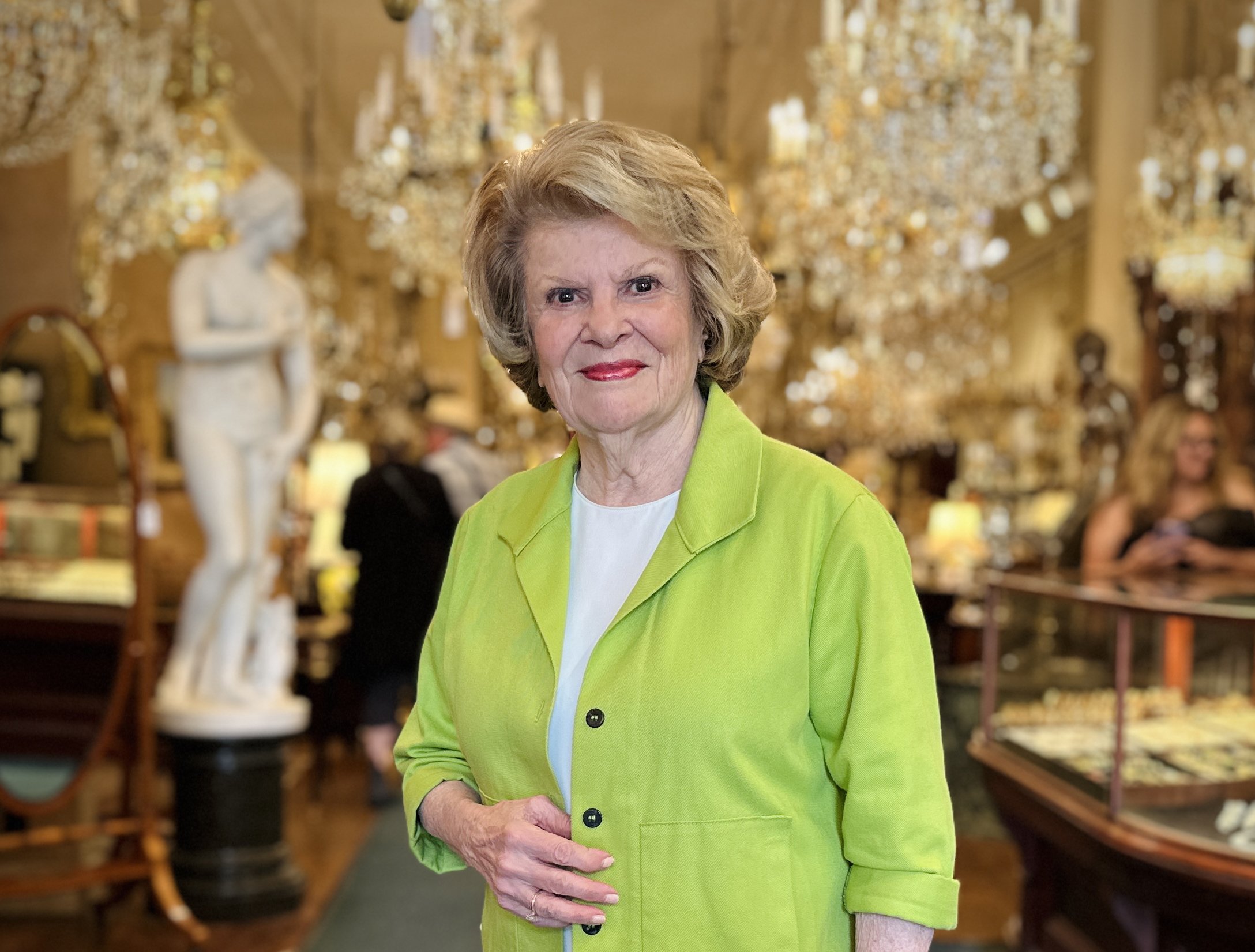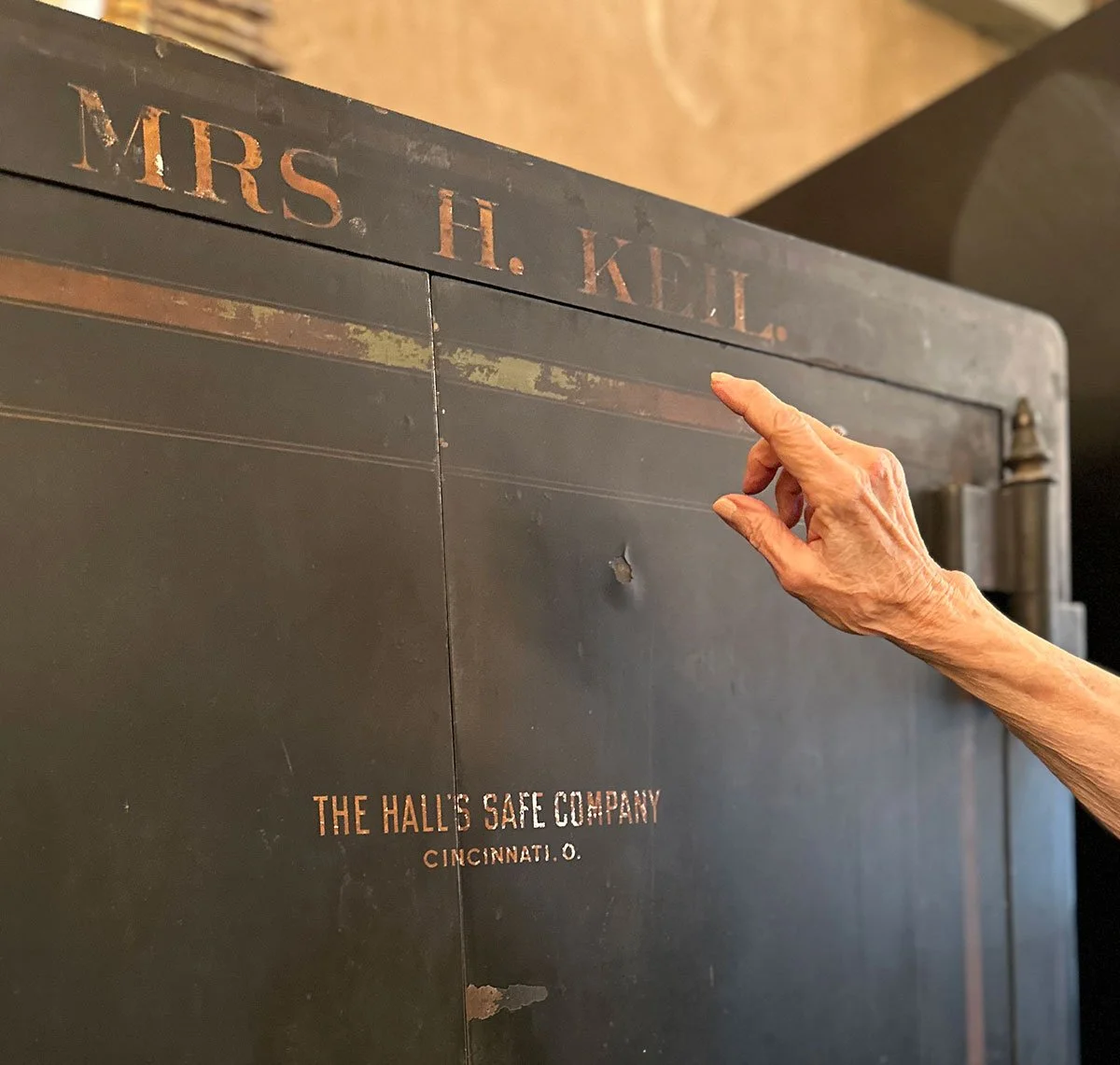The First Lady of New Orleans Antiques: Andrée Keil Moss
Andrée Keil Moss in Keil’s Antiques
July 2024The survivor of a historic shipwreck, this legendary Royal Street antiques authority presides over an enterprise begun 125 years ago by her grandmother – a woman with determination, vision and a love of historic craftsmanship.
– by Bethany Ewald Bultman
- photos by Ellis AndersonThis Quarter Classics column is underwritten in part by Jeannette Bolte, PhD
As the reigning queen of French Quarter antique dealers, Andrée Keil Moss has witnessed the heyday of the Vieux Carre’s world-renowned antique emporiums. But few can match what she survived on her second buying trip to Europe with her parents in 1956 – sixty-eight years ago. Andrée was returning to New Orleans with her first Parisian designer dress, never dreaming she’d nearly perish in a shipwreck.
On Thursday, July 26, the Andrea Doria was making record time on what was to be its 101st transatlantic voyage. The Keils were celebrating their successful two-month buying trip in Europe at the luxury liner’s “last night out party.” Andrée Keil, who was only 20 years old, and her parents dined and danced in the ship’s elegant Belvedere Room. Containers of their antique treasures to be sold in their shop were secure in the hold of the ship. Nantucket was off the bow, although heavy fog made it invisible.
The Andrea Doria at sea, public domain image
Just after 11pm, as the Keils enjoyed the orchestra’s rendition of “Arrivederci Roma,” there was a horrific crash, as the Swedish liner, Stockholm, knifed into the starboard side of the ship. Terrified passengers were hurled across the ballroom. The stately vessel tilted on its side as it ominously glided towards its final resting place, 225 feet below in the Atlantic.
As the elegantly attired guests scurried to the deck, it was discovered that the eight portside lifeboats could not be launched due to the sharp starboard list. So the Keil family found themselves among the 1100 passengers and 500 crew clinging to the deck for dear life.
Finally, at 2:30am, the Ile de France came to the rescue, and survivors were ferried from the sinking ship. As Andrée described to the Times-Picayune on July 27, 1956, she ended up in the same lifeboat as film star Ruth Roman (1922-1999). It took more than an hour to get to the Ile de France. They were soaking wet and freezing, but understood how lucky they were - they’d learn later that 46 people aboard the Andrea Doria had died.
“And then we had to scale up that rope ladder,” Andrée recalled at the time. “We were deeply grateful to be alive.”
The sinking of the Andrea Doria, public domain image
Andrée Keil Moss clearly has survival in her genes. During a recent interview, she glances around the room at the magnificent antiques surrounding her. “I have a legacy to uphold,” she says. “It seems like I have been here my whole life.”
As a youth, she started coming to the shop after school to help out. Then, once she became a teen, she went on buying trips to Europe with her parents. With a smile she adds, “Today I do everything from establishing provenance and pricing our collection to dusting. And there is lots to dust in these 24,000 square feet!”
The store was the vision of her grandmother, Hermina Kahn Keil (1878-1939) who founded Keil’s Antiques. She immigrated from Alsace-Lorraine as a twenty-one-year-old.
“There she was, living in the tiny river town of St. Francisville with her husband and one-year-old baby,” Mrs. Moss explains. “She taught herself English by reading the New York Times!”
In a February 1899 issue of the paper - one that had taken weeks to get to her and been read many before she received it, there was an article that would change her life forever: "How to Start an Old Curiosity Shop."
Mrs. Moss concedes that she has no idea how her grandmother talked her thirty-seven-year-old husband into moving downriver to the port city of New Orleans. But once there, she rented a shop on Royal Street to sell “antiques.” To be clear, not used furniture, but magnificent European furnishings and chandeliers for the homes of the newly-minted gentry.
When Hermina Keil and her family arrived in the French Quarter in 1899, the majority of its inhabitants were impoverished Sicilian immigrants and Creoles. At the time, some city boosters were calling for the demolition of the entire neighborhood. And the concept of collecting “antiques” was no more than a fad. At the time, only one other antiques store was operating on the street.
Courtesy Peter Moss
As the saying goes, “location, location, location.” Hermina astutely selected the perfect one for her specialty antique furniture shop, just a block from the Hotel Monteleone (est. 1866). Mrs. Moss described how astute a businesswoman her grandmother was. “She catered to guests at the Monteleone who were acquiring provisions before embarking on a move to Texas or California.” Of course, the shop was also conveniently located near the port for ease of shipping elegant household goods.
Mrs. Moss recounts that in the early 1900s, one of the owners of Catalina Island, Captain William Banning, had his agents deposit $50k with the Keils to fully furnish their home on the California island. The amount was the equivalent of $1,785,000 in today’s dollars.
That trust was merited. By that time, Hermina was noted as one of the country’s premiere antique authorities. Her discerning eye not only made her among the foremost antique dealers, it helped put New Orleans on the map as a shopping destination for wealthy ranchers and oil barons. Based on her stellar reputation, two American presidents, Theodore Roosevelt and Woodrow Wilson, also became her clients.
“And remember,” adds Mrs. Moss, “this was a time when a woman could not have a bank account in her own name.”
She may not have been able to have a bank account under her own name, but Hermina Keil had a safe with her name on it.
Hermina also had a knack for recruiting a superb staff. “One of these was my mother.” Mrs. Moss goes on to explain how the sixteen-year-old Marie Marguerite Jeanne Andry Poupart (1899-1994) came to work at Keil’s.
“It was during WWI and she needed a job to help support her large French Creole family.” The young woman assured Hermina that she could do “anything and everything!” Once Marguerite found her niche doing Keil Antiques’ books, she suggested that her brothers might also be able to help out Hermina.
“And thus,” she confides, “My shrewd grandmother, Madam Keil, acquired her secret weapon, the five Poupart brothers.” The brothers were hard-working perfectionists, skilled craftsmen who were experts at repairing rare antiques.
After working side by side for many years, Hermina’s son, Morris (1898- 1975) married Marguerite while they were on a buying trip to France, cementing the bond between the families. The couple began to import 18th and 19th-century antiques from Europe, including Chippendale, Louis XVI and Georgian styles.
A few years after her narrow escape during the sinking of the Andrea Doria, Mrs. Moss acquired a second job as a wife and mother. She married the legendary Pete Moss (1928-1987). Many New Orleanians remember Pete Moss as one of the founders of Bacchus. Others remember him as the proprietor of Pete Moss Antiques on Royal Street and the founder of the French Quarter Task Force.
Inside Moss Antiques, 411 Royal Street
Today his legacy lives on in their sons, Keil and Peter Moss, who work alongside their mother. Every piece in both their stores – Keil’s Antiques and Moss Antiques – is still personally selected by Hermina’s descendants, who have formally studied art history and served lengthy apprenticeships to acquire expertise. Contemporary celebrity clients include Nicholas Cage, Oprah Winfrey and Rod Stewart.
2024 marks 125 years since Hermina was inspired by an article in the New York Times and founded a business – one that has aged as well as the fine treasures it carries.
Peter Moss holds the framed obituary of his great-grandmother, Hermina Keil
Andrée Keil Moss and son Peter Moss in Keil Antiques
Your support makes stories like this one possible –please join our Readers’ Circle today!



















